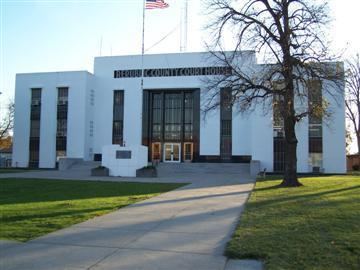Founded February 27, 1860 Website RepublicCounty.org Population 4,820 (2013) Unemployment rate 3.2% (Apr 2015) | Area 1,866 km² | |
 | ||
Rivers Republican River, Cherry Creek, South Fork Mill Creek | ||
Republic County (standard abbreviation: RP) is a county located in the state of Kansas. As of the 2010 census, the county population was 4,980. The largest city and county seat is Belleville. It is south from the Nebraska state line.
Contents
- Map of Republic County KS USA
- Early history
- 19th century
- Geography
- Adjacent counties
- Demographics
- Law and government
- Unified school districts
- Unincorporated cities
- Ghost town
- Townships
- Arts and entertainment
- Athletes
- Clergy
- Journalists
- Medicine
- Philanthropy
- Politicians
- Settlers
- References
Map of Republic County, KS, USA
Early history
For many millennia, the Great Plains of North America was inhabited by nomadic Native Americans. From the 16th century to 18th century, the Kingdom of France claimed ownership of large parts of North America. In 1762, after the French and Indian War, France secretly ceded New France to Spain, per the Treaty of Fontainebleau.
19th century
In 1802, Spain returned most of the land to France, but keeping title to about 7,500 square miles. In 1803, most of the land for modern day Kansas was acquired by the United States from France as part of the 828,000 square mile Louisiana Purchase for 2.83 cents per acre.
In 1854, the Kansas Territory was organized, then in 1861 Kansas became the 34th U.S. state. In 1860, Republic County was established. Republic County was first settled around 1860 by Daniel and Conrad Myers. The territory was principally inhabited by Pawnees, Iowas, and Otoes who peaceable greeted the incoming settlers, who were mostly farmers. By 1868, Republic County was holding elections.
In 1887, Atchison, Topeka and Santa Fe Railway built a branch line from Neva (3 miles west of Strong City) to Superior, Nebraska. This branch line connected Strong City, Neva, Rockland, Diamond Springs, Burdick, Lost Springs, Jacobs, Hope, Navarre, Enterprise, Abilene, Talmage, Manchester, Longford, Oak Hill, Miltonvale, Aurora, Huscher, Concordia, Kackley, Courtland, Webber, Superior. At some point, the line from Neva to Lost Springs was pulled but the right of way has not been abandoned. This branch line was originally called "Strong City and Superior line" but later the name was shortened to the "Strong City line". In 1996, the Atchison, Topeka and Santa Fe Railway merged with Burlington Northern Railroad and renamed to the current BNSF Railway. Most locals still refer to this railroad as the "Santa Fe".
During the late 19th century, Belleville became the urban center for the immigrants that were attracted to the surrounding areas, most notably from Sweden and Bohemia (now Czech Republic).
Geography
According to the 2000 census, the county has a total area of 720.31 square miles (1,865.6 km2), of which 716.38 square miles (1,855.4 km2) (or 99.45%) is land and 3.93 square miles (10.2 km2) (or 0.55%) is water.
Adjacent counties
Demographics
As of the census of 2000, there were 5,835 people, 2,557 households, and 1,685 families residing in the county. The population density was 8 people per square mile (3/km²). There were 3,113 housing units at an average density of 4 per square mile (2/km²). The racial makeup of the county was 98.56% White, 0.26% Black or African American, 0.21% Native American, 0.19% Asian, 0.33% from other races, and 0.46% from two or more races. 0.94% of the population were Hispanic or Latino of any race. 24.1% were of German, 13.6% Swedish, 12.4% Czech, 9.2% English, 9.0% Irish and 8.6% American ancestry according to Census 2000.
There were 2,557 households out of which 25.60% had children under the age of 18 living with them, 58.80% were married couples living together, 4.80% had a female householder with no husband present, and 34.10% were non-families. 31.80% of all households were made up of individuals and 18.00% had someone living alone who was 65 years of age or older. The average household size was 2.23 and the average family size was 2.80.
In the county, the population was spread out with 22.30% under the age of 18, 4.50% from 18 to 24, 22.10% from 25 to 44, 25.00% from 45 to 64, and 26.10% who were 65 years of age or older. The median age was 46 years. For every 100 females there were 93.20 males. For every 100 females age 18 and over, there were 90.80 males.
The median income for a household in the county was $30,494, and the median income for a family was $39,215. Males had a median income of $25,260 versus $17,274 for females. The per capita income for the county was $17,433. About 6.00% of families and 9.10% of the population were below the poverty line, including 12.40% of those under age 18 and 8.90% of those age 65 or over.
Law and government
Republic County was a prohibition, or "dry", county until the Kansas Constitution was amended in 1986 and voters approved the sale of alcoholic liquor by the individual drink with a 30% food sales requirement.
Unified school districts
Unincorporated cities
Ghost town
Townships
Republic County is divided into twenty townships. The city of Belleville is considered governmentally independent and is excluded from the census figures for the townships. In the following table, the population center is the largest city (or cities) included in that township's population total, if it is of a significant size.
